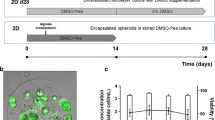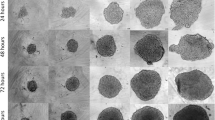Abstract
The liver is essential in the elimination of environmental and food contaminants. Given the interspecies differences between rodents and humans, the development of relevant in vitro human models is crucial to investigate liver functions and toxicity in cells that better reflect pathophysiological processes. Classically, the differentiation of the hepatic HepaRG cell line requires high concentration of dimethyl sulfoxide (DMSO), which restricts its usefulness for drug-metabolism studies. Herein, we describe undifferentiated HepaRG cells embedded in a collagen matrix in DMSO-free conditions that rapidly organize into polarized hollow spheroids of differentiated hepatocyte-like cells (Hepoid-HepaRG). Our conditions allow concomitant proliferation with high levels of liver-specific functions and xenobiotic metabolism enzymes expression and activities after a few days of culture and for at least 4 weeks. By studying the toxicity of well-known injury-inducing drugs by treating cells with 1- to 100-fold of their plasmatic concentrations, we showed appropriate responses and demonstrate the sensitivity to drugs known to induce various degrees of liver injury. Our results also demonstrated that the model is well suited to estimate cholestasis and steatosis effects of drugs following chronic treatment. Additionally, DNA alterations caused by four genotoxic compounds (Aflatoxin B1 (AFB1), Benzo[a]Pyrene (B[a]P), Cyclophosphamide (CPA) and Methyl methanesulfonate (MMS)) were quantified in a dose-dependent manner by the comet and micronucleus assays. Their genotoxic effects were significantly increased after either an acute 24 h treatment (AFB1: 1.5–6 μM, CPA: 2.5–10 μM, B[a]P: 12.5–50 μM, MMS: 90–450 μM) or after a 14-day treatment at much lower concentrations (AFB1: 0.05–0.2 μM, CPA: 0.125–0.5 μM, B[a]P: 0.125–0.5 μM) representative to human exposure. Altogether, the DMSO-free 3D culture of Hepoid-HepaRG provides highly differentiated and proliferating cells relevant for various toxicological in vitro assays, especially for drug-preclinical studies and environmental chemicals risk assessment.





Similar content being viewed by others
Abbreviations
- CYP:
-
Cytochrome P450
- DMSO:
-
Dimethyl sulfoxide
- AFB1 :
-
Aflatoxin B1
- B[a]P:
-
Benzo[a]Pyrene
- CPA:
-
Cyclophosphamide
- MMS:
-
Methylmethane sulfonate
- PHH:
-
Primary human hepatocytes
References
Aithal GP et al (2011) Case definition and phenotype standardization in drug-induced liver injury. Clin Pharmacol Ther 89:806–815
Aleksandrova AV, Burmistrova OA, Fomicheva KA, Sakharov DA (2016) Maintenance of high cytochrome P450 expression in HepaRG cell spheroids in DMSO-free medium. Bull Exp Biol Med 161:120–124
Aninat C et al (2006) Expression of cytochromes P450, conjugating enzymes and nuclear receptors in human hepatoma HepaRG cells. Drug Metab Dispos Biol Fate Chem 34:75–83
Anthérieu S et al (2010) Stable expression, activity, and inducibility of cytochromes P450 in differentiated HepaRG cells. Drug Metab Dispos Biol Fate Chem 38:516–525
Anthérieu S, Rogue A, Fromenty B, Guillouzo A, Robin M-A (2011) Induction of vesicular steatosis by amiodarone and tetracycline is associated with up-regulation of lipogenic genes in HepaRG cells. Hepatol Baltim Md 53:1895–1905
Bell CC et al (2016) Characterization of primary human hepatocyte spheroids as a model system for drug-induced liver injury, liver function and disease. Sci Rep 6:25187
Bhattacharya M et al (2012) Nanofibrillar cellulose hydrogel promotes three-dimensional liver cell culture. J Control Release off J Control Release Soc 164:291–298
Bomo J et al (2016) Increasing 3D matrix rigidity strengthens proliferation and spheroid development of human liver cells in a constant growth factor environment. J Cell Biochem 117:708–720
Bucher S et al (2018) Co-exposure to benzo[a]pyrene and ethanol induces a pathological progression of liver steatosis in vitro and in vivo. Sci Rep 8:5963
Cerec V et al (2007) Transdifferentiation of hepatocyte-like cells from the human hepatoma HepaRG cell line through bipotent progenitor. Hepatol Baltim Md 45:957–967
Chatterjee S, Richert L, Augustijns P, Annaert P (2014) Hepatocyte-based in vitro model for assessment of drug-induced cholestasis. Toxicol Appl Pharmacol 274:124–136
Conway GE et al (2020) Adaptation of the in vitro micronucleus assay for genotoxicity testing using 3D liver models supporting longer-term exposure durations. Mutagenesis 35:319–330
Cuvellier M et al (2021) 3D culture of HepaRG cells in GelMa and its application to bioprinting of a multicellular hepatic model. Biomaterials 269:120611
Darnell M et al (2011) Cytochrome P450-dependent metabolism in HepaRG cells cultured in a dynamic three-dimensional bioreactor. Drug Metab Dispos Biol Fate Chem 39:1131–1138
Deavall DG, Martin EA, Horner JM, Roberts R (2012) Drug-induced oxidative stress and toxicity. J Toxicol 2012:645460
Freag MS et al (2021) Human Nonalcoholic Steatohepatitis on a Chip. Hepatol Commun 5:217–233
Gripon P et al (2002) Infection of a human hepatoma cell line by hepatitis B virus. Proc Natl Acad Sci USA 99:15655–15660
Grix T et al (2018) Bioprinting perfusion-enabled liver equivalents for advanced organ-on-a-chip applications. Genes 9(4):176
Guengerich FP (1997) Comparisons of catalytic selectivity of cytochrome P450 subfamily enzymes from different species. Chem Biol Interact 106:161–182
Guengerich FP (2003) Cytochromes P450, drugs, and diseases. Mol Interv 3:194–204
Gunness P et al (2013) 3D organotypic cultures of human HepaRG cells: a tool for in vitro toxicity studies. Toxicol Sci off J Soc Toxicol 133:67–78
Guo X, Seo J-E, Li X, Mei N (2020) Genetic toxicity assessment using liver cell models: past, present, and future. J Toxicol Environ Health B Crit Rev 23:27–50
Hendriks DFG, Fredriksson Puigvert L, Messner S, Mortiz W, Ingelman-Sundberg M (2016) Hepatic 3D spheroid models for the detection and study of compounds with cholestatic liability. Sci Rep 6:35434
Higuchi Y et al (2016) Functional polymer-dependent 3D culture accelerates the differentiation of HepaRG cells into mature hepatocytes. Hepatol Res off J Jpn Soc Hepatol 46:1045–1057
Hiller T et al (2018) Generation of a 3D liver model comprising human extracellular matrix in an alginate/gelatin-based bioink by extrusion bioprinting for infection and transduction studies. Int J Mol Sci 19(10):3129
Jossé R et al (2008) Long-term functional stability of human HepaRG hepatocytes and use for chronic toxicity and genotoxicity studies. Drug Metab Dispos Biol Fate Chem 36:1111–1118
Jossé R, Rogue A, Lorge E, Guillouzo A (2012) An adaptation of the human HepaRG cells to the in vitro micronucleus assay. Mutagenesis 27:295–304
Kanebratt KP, Andersson TB (2008) Evaluation of HepaRG cells as an in vitro model for human drug metabolism studies. Drug Metab Dispos Biol Fate Chem 36:1444–1452
Kim D-S et al (2017) A liver-specific gene expression panel predicts the differentiation status of in vitro hepatocyte models. Hepatol Baltim Md 66:1662–1674
Kozyra M et al (2018) Human hepatic 3D spheroids as a model for steatosis and insulin resistance. Sci Rep 8:14297
Kvist AJ et al (2018) Critical differences in drug metabolic properties of human hepatic cellular models, including primary human hepatocytes, stem cell derived hepatocytes, and hepatoma cell lines. Biochem Pharmacol 155:124–140
Le Hegarat L et al (2010) Assessment of the genotoxic potential of indirect chemical mutagens in HepaRG cells by the comet and the cytokinesis-block micronucleus assays. Mutagenesis 25:555–560
Le Vee M et al (2006) Functional expression of sinusoidal and canalicular hepatic drug transporters in the differentiated human hepatoma HepaRG cell line. Eur J Pharm Sci off J Eur Fed Pharm Sci 28:109–117
Lee H-J et al (2017) Elasticity-based development of functionally enhanced multicellular 3D liver encapsulated in hybrid hydrogel. Acta Biomater 64:67–79
Leite SB et al (2012) Three-dimensional HepaRG model as an attractive tool for toxicity testing. Toxicol Sci off J Soc Toxicol 130:106–116
Lin R-Z, Lin R-Z, Chang H-Y (2008) Recent advances in three-dimensional multicellular spheroid culture for biomedical research. Biotechnol J 3:1172–1184
Lübberstedt M et al (2011) HepaRG human hepatic cell line utility as a surrogate for primary human hepatocytes in drug metabolism assessment in vitro. J Pharmacol Toxicol Methods 63:59–68
Mandon M, Huet S, Dubreil E, Fessard V, Le Hégarat L (2019) Three-dimensional HepaRG spheroids as a liver model to study human genotoxicity in vitro with the single cell gel electrophoresis assay. Sci Rep 9:10548
Mayati A et al (2018) Functional polarization of human hepatoma HepaRG cells in response to forskolin. Sci Rep 8:16115
Mueller D, Krämer L, Hoffmann E, Klein S, Noor F (2014) 3D organotypic HepaRG cultures as in vitro model for acute and repeated dose toxicity studies. Toxicol in Vitro 28:104–112
Murayama N, Usui T, Slawny N, Chesné C, Yamazaki H (2015) Human HepaRG cells can be cultured in hanging-drop plates for cytochrome P450 induction and function assays. Drug Metab Lett 9:3–7
Nauwelaers G et al (2011) DNA adduct formation of 4-aminobiphenyl and heterocyclic aromatic amines in human hepatocytes. Chem Res Toxicol 24:913–925
Nauwelaërs G, Bellamri M, Fessard V, Turesky RJ, Langouët S (2013) DNA adducts of the tobacco carcinogens 2-amino-9H-pyrido[2,3-b]indole and 4-aminobiphenyl are formed at environmental exposure levels and persist in human hepatocytes. Chem Res Toxicol 26:1367–1377
Oorts M et al (2016) Drug-induced cholestasis risk assessment in sandwich-cultured human hepatocytes. Toxicol Vitro Int J Publ Assoc BIBRA 34:179–186
Parmentier C et al (2018) Inter-individual differences in the susceptibility of primary human hepatocytes towards drug-induced cholestasis are compound and time dependent. Toxicol Lett 295:187–194
Quesnot N et al (2016) Evaluation of genotoxicity using automated detection of γH2AX in metabolically competent HepaRG cells. Mutagenesis 31:43–50
Rebelo SP et al (2015) HepaRG microencapsulated spheroids in DMSO-free culture: novel culturing approaches for enhanced xenobiotic and biosynthetic metabolism. Arch Toxicol 89:1347–1358
Rose S et al (2021) Generation of proliferating human adult hepatocytes using optimized 3D culture conditions. Sci Rep 11:515
Saito J et al (2016) High content analysis assay for prediction of human hepatotoxicity in HepaRG and HepG2 cells. Toxicol Vitro Int J Publ Assoc BIBRA 33:63–70
Santos NC, Figueira-Coelho J, Martins-Silva J, Saldanha C (2003) Multidisciplinary utilization of dimethyl sulfoxide: pharmacological, cellular, and molecular aspects. Biochem Pharmacol 65:1035–1041
Schrader J et al (2011) Matrix stiffness modulates proliferation, chemotherapeutic response and dormancy in hepatocellular carcinoma cells. Hepatol Baltim Md 53:1192–1205
Schulze A, Mills K, Weiss TS, Urban S (2012) Hepatocyte polarization is essential for the productive entry of the hepatitis B virus. Hepatol Baltim Md 55:373–383
Souza AG et al. (2018) Comparative assay of 2D and 3D cell culture models: proliferation, gene expression and anticancer drug response. Curr Pharm Des.
Štampar M et al (2021) Hepatocellular carcinoma (HepG2/C3A) cell-based 3D model for genotoxicity testing of chemicals. Sci Total Environ 755:143255
Steiner MG, Babbs CF (1990) Quantitation of the hydroxyl radical by reaction with dimethyl sulfoxide. Arch Biochem Biophys 278:478–481
Susukida T et al (2016) Establishment of a drug-induced, bile acid-dependent hepatotoxicity model using HepaRG cells. J Pharm Sci 105:1550–1560
Takahashi Y et al (2015) 3D spheroid cultures improve the metabolic gene expression profiles of HepaRG cells. Biosci Rep 35(3):e00208
Takayama K et al (2013) 3D spheroid culture of hESC/hiPSC-derived hepatocyte-like cells for drug toxicity testing. Biomaterials 34:1781–1789
Vorrink S, Zhou Y, Ingelman-Sundberg M, Lauschke VM (2018) Prediction of drug-induced hepatotoxicity using long-term stable primary hepatic 3D spheroid cultures in chemically defined conditions. Toxicol Sci off J Soc Toxicol. https://doi.org/10.1093/toxsci/kfy058
Funding
With financial supports from ITMO Cancer of AVIESAN (National Alliance for Life Sciences & Health) within the framework of the Cancer Plan, the Institut National de la Santé et de la Recherche Médicale (Inserm), University of Rennes 1, PNREST Anses Cancer TMOI AVIESAN 2013/1/166, la Ligue contre le cancer du grand Ouest, the Région Bretagne and SATT Ouest valorisation.
Author information
Authors and Affiliations
Corresponding authors
Ethics declarations
Conflict of interest
The authors declare that they have no conflict of interest.
Additional information
Publisher's Note
Springer Nature remains neutral with regard to jurisdictional claims in published maps and institutional affiliations.
Supplementary Information
Below is the link to the electronic supplementary material.
Rights and permissions
About this article
Cite this article
Rose, S., Cuvellier, M., Ezan, F. et al. DMSO-free highly differentiated HepaRG spheroids for chronic toxicity, liver functions and genotoxicity studies. Arch Toxicol 96, 243–258 (2022). https://doi.org/10.1007/s00204-021-03178-x
Received:
Accepted:
Published:
Issue Date:
DOI: https://doi.org/10.1007/s00204-021-03178-x




